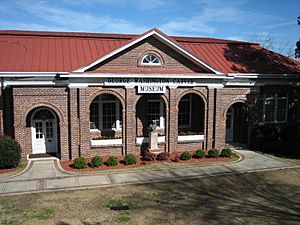The George Washington Carver Museum facts for kids
The George Washington Carver Museum is a special place in Tuskegee, Alabama, United States. It is part of the Tuskegee Institute National Historic Site. The museum is located on the campus of Tuskegee University. The US National Park Service manages it, offering self-guided tours.
This museum has many interesting exhibits. You can learn about crop rotation ideas that helped the Southern United States's economy. It also tells the amazing story of George Washington Carver himself.
Contents
Discovering George Washington Carver's Legacy
The George Washington Carver Museum was created to share the life and work of Dr. George Washington Carver. He was a brilliant scientist and inventor. He wanted his work to inspire young people to live better lives.
The museum was built with help from Henry Ford, a famous industrialist. Dr. Carver hoped that everyone, especially children, would learn from his exhibits. He wanted his discoveries to be available for the good of all people.
Carver's Early Life and Work
Dr. George Washington Carver worked at Tuskegee Institute for over forty years. He was born to an enslaved woman. He stayed on Moses Carver's farm until he was 12 years old.
Even as a child, he loved to paint pictures of plants and landscapes. He always worked to improve life for farmers, especially in the South. He used science to find new uses for natural resources.
What You'll See at the Museum
The museum has many exhibits and programs. You can watch films about George Washington Carver and Booker T. Washington. There is also a book sales area.
The original museum displayed many of Carver's collections. These included rocks, fungi, and his own artwork. He also showed mounted bird specimens and giant vegetables. He used these for "show and tell" at farm fairs.
His last laboratory was even housed inside the Carver Museum. Here, he conducted many of his famous experiments. He started his research with only one real scientific tool: a microscope.
You can see some of his laboratory equipment. This includes parts of old, discarded tools he used to set up his first lab. There are also samples of products he made from peanuts and sweet potatoes.
The museum also shows his artistic side. You can see his paintings, embroidery, and needlework. Plaques, medals, and other tributes to Dr. Carver are also on display.
The Museum's Journey Through Time
The George Washington Carver Museum was officially approved in 1938. This was at the request of President Frederick D. Patterson of Tuskegee Institute. The museum building used to be the school laundry.
It held Dr. Carver's huge collections of plants, minerals, and birds. It also displayed his products from the peanut, sweet potato, and clays. His many paintings, drawings, and textile art were also here.
Mr. and Mrs. Henry Ford formally dedicated the museum in 1941. Dr. Carver passed away in January 1943. He was buried in the Campus Cemetery.
Challenges and Renovations
In 1947, a fire caused a lot of damage to the museum. Luckily, many of Dr. Carver's products were not badly harmed. However, only a few of his paintings were saved. Most of these were damaged by smoke and water.
The building was renovated in 1951. It was made larger to include a basement exhibit area. It became a place to store historical items donated to Tuskegee Institute. It also held a large collection of African crafts and artifacts.
From 1951 to 1962, Bess Bolden Walcott was the museum's curator. Her hard work helped the museum become a National Park Service site. The Tuskegee Institute National Historic Site was created in 1974. It was officially established on November 13, 1977.
The George Washington Carver Museum and Booker T. Washington's home, "The Oaks," were then given to the people of the United States.
Modernizing the Museum
Both the museum and "The Oaks" were closed in February 1980. They needed to be restored and updated. The museum's outside was restored to its original look.
The inside of the building was completely rebuilt. It now has modern exhibits, storage for artifacts, and staff offices. There is also an auditorium for films and an elevator for visitors with disabilities.
Tuskegee Institute's Story
One part of the museum shows the history of Tuskegee Institute. It was founded in 1881 and is now Tuskegee University. Through photos and artifacts, the exhibits show the school's achievements. This includes its work helping farmers and collecting information about Black life.
Visitors who came to the museum in the past might notice fewer items on display now. This is because it's not necessary to show every single item to tell the full story. Items not on display are kept safe in a special storage area. Tuskegee University still owns many of the African artifacts that used to be displayed.
See also


